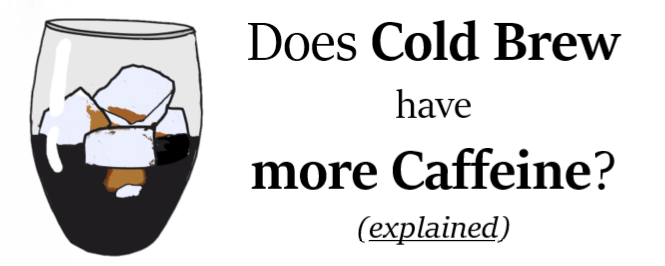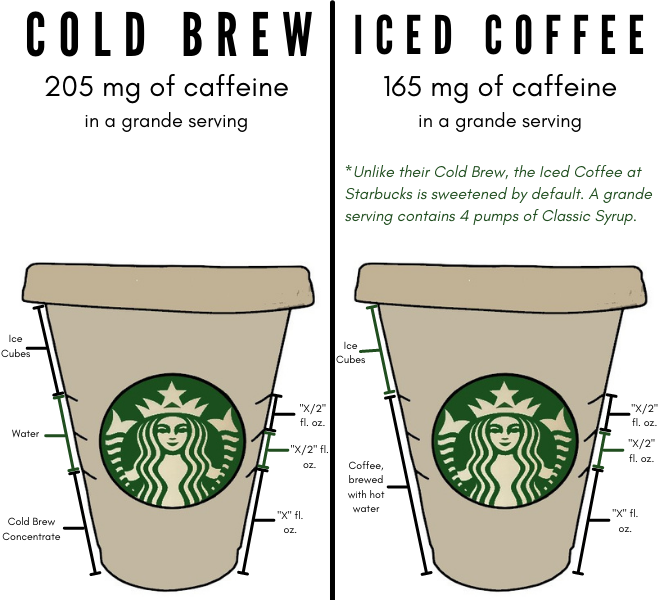Cold brewing has quite a few alleged advantages over other coffee brewing methods.
One of those advantages, proclaimed by its loyal fans, is that cold brew coffee contains more caffeine than regular coffee, brewed with hot water. But is this actually true?
Is a cup of cold brew always stronger than a cup of ordinary iced coffee?
Is the caffeine content in a milliliter of cold brew concentrate higher than in a milliliter of espresso or drip coffee? If it’s not, then why is a serving of cold brew at Starbucks more caffeinated than their iced lattes and other iced coffee drinks?
In this post I’ll give you all the answers, so keep reading!
Does Cold Brew Have More Caffeine?
Generally, hot water extracts caffeine from coffee grounds more efficiently than cold water.
That’s why, when you brew coffee with cold water you need to steep the grounds for much longer to compensate for the lack of optimal extraction temperature.
Having said that, cold brew is usually made as a concentrate with a higher coffee-to-water ratio compared to hot brew (often, more than 2 times higher).
That’s why cold brew concentrate is diluted with water before being served.
Nevertheless, even after dilution, because it’s prepared by using a much larger amount of ground coffee, a 12 fl. oz. (350 ml) cup of cold brew often has more caffeine than a 12 fl. oz. (350 ml) cup of regular iced coffee.
With that being said, if you brew a batch of hot brew and a batch of cold brew, and you use the exact same grind size and coffee-to-water ratio for the making of both of them, there won’t be a significant difference between their caffeine content. There are some scientific reports that also confirm that.
Nevertheless, there is a significant dissimilarity between the amounts of ground beans that are used for the making of regular coffee and cold brew coffee.
For example, I use 60 grams (2 oz.) of coffee grounds when making a liter (34 fl. oz.) of French press coffee. When making a batch of cold brew with the same amount of water I use 2.6 times more ground beans – 160 grams (5.6 oz.).
By doing so I get a cold brew concentrate which I dilute with water in a 1:1 ratio (equal parts of cold brew and water).
At Starbucks, they use pretty much the same as the aforementioned coffee-to-water ratios for, respectively, hot and cold brew.
When you order a cold brew, the barista adds concentrate to the first line of the Starbucks cup, dilutes with water to the third cup line, and then fills up the cup with ice cubes. When preparing an iced coffee, the barista fills up the cup with coffee to the third line and then adds the ice cubes.
A Starbucks grande cup (16 fl. oz., 470 ml) of cold brew contains 205 mg of caffeine, while a grande cup of regular Starbucks iced coffee contains 165 mg of caffeine.
The 50% dilution with water isn’t enough to compensate for the 2.6 times higher coffee-to-water ratio used in the making of their cold brew concentrate.
That’s why Starbucks’ iced coffee contains less caffeine than their cold brew.
Meanwhile, at Dunkin, a medium-sized cup of cold brew contains less caffeine than a medium-sized cup of iced coffee. So I guess they either use different coffee-to-water ratios, or they dilute the cold brew concentrate with more water.
So, as with all types of coffee, the strength of cold brew largely depends on the amount of ground beans that you use in the making of a batch.
Author’s Note: Did you know that you can use cold brew concentrate to prepare a cup of hot coffee? Visit the link to learn more!
Caffeine in Cold Brew Compared to Espresso
When it comes to strongly-caffeinated coffee, many people believe that nothing can beat espresso. To be fair, they aren’t that far from the truth.
But does a shot of espresso contain more caffeine than a cup of cold brew?
According to this scientific report, 100 milliliters (3.4 fl. oz.) of espresso contain 253.4 mg of caffeine (average value).
On the other hand, 100 milliliters (3.4 fl. oz.) of cold brew coffee contain only 85 milligrams of caffeine (on average).
With that being said, a shot of espresso is only 30 ml to 44 ml (1 to 1.5 fl. oz.) while a serving of cold brew starts at 340 ml (12 fl. oz).
In other words, an ounce of espresso contains more caffeine than an ounce of cold brew, but because of the difference in their serving sizes, a cup of cold brew coffee would contain more caffeine than a cup of espresso.
So we should always take into consideration the standard serving sizes of the coffee drinks we compare, in order to determine which one practically contains more caffeine.
Iced lattes are made with espresso, but they’re often less caffeinated than a serving of cold brew.
At Starbucks, a grande iced latte is made with 2 espresso shots and contains 150 mg of caffeine, so the espresso shots can’t beat the strength of the cold brew.
So if you’re at Starbucks and you’re looking for a beverage that will give you a strong caffeine kick, then get cold brew coffee. Even a quad iced espresso at Starbucks made with 4 espresso shots (300 mg of caffeine) doesn’t contain more caffeine than a venti cold brew (310 mg of caffeine).
Related Post: Strongest Drinks At Starbucks in Terms of Caffeine.
With that being said, some coffee shops may use other cold brew recipes that result in a less-caffeinated cup of coffee.
Even though most coffee shops don’t have the caffeine content of their drinks listed, you can always ask the barista to shed some light on the approximate strength of the drink that you’re ordering.
Conclusion
Whether cold brew contains more or less caffeine than hot brew depends on many factors. Some of them are:
- The coffee-to-water ratio used when preparing the cold brew.
- The amount of water that is used to dilute the cold brew concentrate.
- The serving size of the cold brew and the coffee drink you’re comparing it to.
With that being said, more often than not, a cup of cold brew is stronger than a cup of iced coffee, drip coffee, or a shot of espresso.
So whenever you order one at your favorite coffee shop, don’t be surprised if it makes you a bit jittery.
I hope that you found my post useful. Leave me a comment below in case you have any questions or simply share your thoughts.



